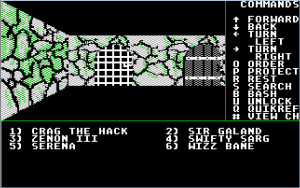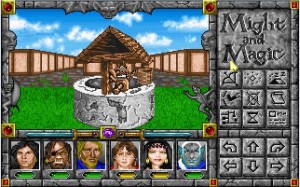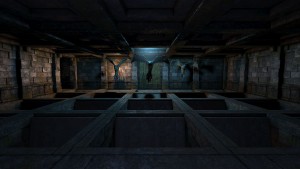Old-School RPG Design – Navigating and Exploring
Posted by Rampant Coyote on February 12, 2015
 So I was going to do some research. Just… you know, research. I’m always trying to capture the feel of “old-school” gaming in Frayed Knights, and so I thought I’d go back and check out Might & Magic Book 1 – The Secret of the Inner Sanctum. So I got hooked on it once, but on a new computer I had to start over, and I’m really only going to take a peek for just a few minutes around the world. Well, okay, I’ll spend time making characters, just for old time’s sake (screenshot with the pre-gen characters notwithstanding), and THEN I’ll just poke around for maybe a half hour. Not very long at all. Just as a refresher.
So I was going to do some research. Just… you know, research. I’m always trying to capture the feel of “old-school” gaming in Frayed Knights, and so I thought I’d go back and check out Might & Magic Book 1 – The Secret of the Inner Sanctum. So I got hooked on it once, but on a new computer I had to start over, and I’m really only going to take a peek for just a few minutes around the world. Well, okay, I’ll spend time making characters, just for old time’s sake (screenshot with the pre-gen characters notwithstanding), and THEN I’ll just poke around for maybe a half hour. Not very long at all. Just as a refresher.
Yeah. Right. That plan didn’t work. This is Might & Magic that we’re talking about. Nevermind I’ve got tons of cool new games waiting to be played – I’m now a few hours into Might & Magic 1. Again.
The thing is, these classic old games succeed – at least for me – on a level that many of their modern (yeah, indie) imitators do not. I know – I play ’em. I *cough* make ’em. How is that possible? There’s no inimitable genius here or technological or design wizardry (pun intended) going on in this game that’s pushing 30 years old (for the Apple II version). What gets missed? What’s so addictive for an old-school gamer like myself?
There are a lot of answers to that question, but I’m going to focus on something that gets lost a lot in modern RPGs – indies included. The most basic interactions of not only these old games, but of almost all games. Movement.
Movement in these old first-person dungeon crawlers is pretty basic. You can turn left or right, move forward, or move back. Some of the games also allowed you to move left or right. In these gridded game worlds, each step was a full square, so if nothing intervened, you could traverse the entire map for a level in seconds.
There’s our first little bit of possibly accidental brilliance – movement was really fast unless something interesting happened. This, at least, a lot of games “get.”
But something interesting happened a lot. That’s a probably intentional piece of brilliance, especially in the Might & Magic series. Not just getting into fights. Might & Magic 1 cribbed from the best of the genre, so it’s not like Jon Van Caneghem was startlingly original. He just did it very well. The game doesn’t stoop to the level of Wizardry 4, where practically every step was a torturous exercise in “messing with” the player (which actually came out a year later). But even in wandering around the starting city, you really can’t take anything for granted.
 So what goes into walking around a gridded area in these RPGs? What is the world like, and what kind of state information can be accessed or manipulated?
So what goes into walking around a gridded area in these RPGs? What is the world like, and what kind of state information can be accessed or manipulated?
Well, first, you have the player’s party. They have an X and Y coordinate, a facing, and a movement direction. The movement direction is usually the same as their facing direction, but not necessarily.
Then you have the map itself. For every square in the grid you may have an event tied to it, and you have four possible directions of movement which may be allowed or restricted. There are visuals representing this. If you can’t go in a direction, you’ll usually see some kind of wall or barrier. If movement is restricted by some means, you’ll often find a gate or door of some kind. And if you can pass freely, you’ll usually see nothing at all – just the square beyond.
But from there, things can get really interesting. What if there’s no natural illumination, causing no visual at all unless the player creates some form of light? What if the wall is actually an illusion, allowing the player passage but they have to hunt for it? What if a square allows movement into the next square, but that square doesn’t allow reciprocal movement back? In other words, you find you can only move one way? What if an event is triggered not only by entering the square, but based on your facing when you enter it? Then of course, there are the infamous invisible walls. Probably not the most enjoyable gameplay option, but it’s an option.
As far as events, some can mess with your state. Change your facing (an old, and somewhat annoying trick in the old days without automapping). Move you to a different location, possibly on another level (like pits dropping you to the next level), and possibly without warning or notification (leading to one of the notorious “infinite hallway” effects…)
And we can go further than this. What about the order in which the squares are entered or interacted with? How about squares that change their information based on interactions – walls moving, doors opening, illumination changing, an impassible chasm turning into a bridge, etc. Or just the event triggers changing based on other events in the dungeon. How about the timing in which you enter the square?
 One of the best modern examples of this is the Legend of Grimrock series, although it was of course inspired by the Dungeon Master and Eye of the Beholder series. In these games, the dungeon feels much more like a collection of puzzles, and there’s definitely more of a feeling of “solving” a level more than exploring it. But the complex interactions of the map and movement across it are there.
One of the best modern examples of this is the Legend of Grimrock series, although it was of course inspired by the Dungeon Master and Eye of the Beholder series. In these games, the dungeon feels much more like a collection of puzzles, and there’s definitely more of a feeling of “solving” a level more than exploring it. But the complex interactions of the map and movement across it are there.
And that, ladies and not-ladies, is a key part of the nature of these “old-school” western RPGs, and least within the “first person perspective” genre. Something many indie games would be well-advised to consider. Movement is not just something you do to get from one event to the other. Movement is a major gameplay mechanic. Exploration – truly discovering all the little tricky interactions and secrets and advantages – is not a second-class mechanic. It’s not just something you do to find some bonus treasure. There were a whole bunch of puzzles, tricks, and gameplay to be found that had nothing to do with all the other RPG mechanics, like your inventory or experience or hit points – just with your location and orientation and the map state.
This can be fun. I think that’s what keeps getting forgotten in some modern attempts. Sure, it can get old after a while, too (a weakness in Legend of Grimrock), so it should be mixed with a variety of gameplay elements to keep things interesting (just like combat after combat can get very old very quickly). But it should be no great exaggeration to say that exploring the map is half the fun.
Filed Under: Design - Comments: 15 Comments to Read
Charles said,
That was a consideration I had actually but I came to a different conclusion. I wasn’t overly fond of hunting for fake walls in MM. It came down to looking at my apparently finished grid map and filling in the blanks. So I narrowed it down to slides, barriers and walls that turned out to be sliding doors that could be opened with the right tool. Or waiting to have the etherealize spell (newly called “Spirit Bodies”). Oh there’s the occasional teleport as well. But not nearly as dense as MMI where these tricks are in many, if not most indoor areas.
The frequency at which these things happen in MM fits with the general whackiness of the games (like the beyond unlikely encounters). It exonerates itself of any form of coherence and realism which, in part, works well because of the simplicity of the narrative and graphic display. But if the game aims to be somewhat more realistic it becomes difficult to justify dungeons with all these tricks. So while I do use many of them I do so more sporadically and in places where the narrative works to justify it.
These tend to be in more advanced areas and therefore require more playing time… Hint hint kthxbye 😉
Rampant Coyote said,
Some of it got taken to extremes in some of the older games (again, Wizardry 4 comes to mind). Even in Legend of Grimrock, there is a point where there can be Too Much of a Good Thing.
The point wasn’t intended to be that there should be all these twists to a gridded system. Especially things like invisible walls or damage squares or whatnot… that stuff gets old almost immediately. But it was more to point out how they took advantage of what they had even in these simple systems – and made them interesting. Not that every other square should be something weird.
In Frayed Knights, I don’t use a gridded system at all, but this is something of a reminder to me about the need to keep the wandering-around parts interesting and fun.
corwin said,
I thought the latest M&MX did this rather well and was a large part of its charm. I agree with what both of you think, but Jay, why not put one of these ‘old skule’ dungeons in FK2, I think it would be a blast. 🙂
Rampant Coyote said,
I loved M&M X. I thought they nailed it. In any previous year, it would have been my pick for RPG of the year. It’s only Ubisoft’s bad fortune (and our wonderful fortune) that this was a year of *fantastic* RPGs.
And… Corwin, you figured out just WHY I was revisiting Might & Magic 1. 🙂 I’m actually required to put one of those dungeons in, courtesy of Brian “Psychochild” Green.
Kyle Haight said,
Why do I suspect it will be in the basement of an old, abandoned school?
Rampant Coyote said,
Because that’s how I roll, baby! Give Kyle a cigar!
Besides, how could it NOT be?
Felipepepe said,
So I take Frayed Knights 2 is going to be step-based? 😉
Rampant Coyote said,
Nah, although I wouldn’t be opposed to doing a step-based RPG in the future. However, my line of thinking here was like this: If there’s all this stuff you can do with step-based movement with such simple commands, how much more *should* you be able to do with a more advanced & detailed control scheme, right?
Maklak said,
[quote]In Frayed Knights, I don’t use a gridded system at all, but this is something of a reminder to me about the need to keep the wandering-around parts interesting and fun.[/quote]
Wandering around in FK was OK and even fun at times (I liked the first temple, the town, the small cave with ogres, ruined building with a ceiling lurker and a few other places), except for two places. One was Goblintown, which felt like if someone duct-taped several dungeons together for no reason. The oter was circular hole in the ground in the corner of that last big area with multiple dungeons. The un-fun part was that there were a lot of bridges over gaps with no railings an it was too easy to fall down.
Cuthalion said,
In these gridded game worlds, each step was a full square, so if nothing intervened, you could traverse the entire map for a level in seconds.
This is actually the main thing keeping me from going back to Frayed Knights to try and finish it (I’m still working through the Tower of Almost Death). Every time I go back to heal up or something, I feel like I’m trudging. There’s a lot of space I recall between the dungeon and the zone border, then between the zone border and the inn and between the stuff in the town itself. It might not actually be that much, but it starts to feel like it.
Now, this isn’t to say that Frayed Knights is a bad game. Just that I don’t have as much tolerance for walking back and forth as I used to. 😛
Rampant Coyote said,
You aren’t wrong. That’s something I’m working on with the sequel (the shorter load times will definitely help, too).
Cuthalion said,
Yaaay! I think the idea of having to budget things and make going back to town part of the rhythm of the game was a good one. It’s just that instead of being part of the rhythm, it broke the rhythm.
I still plan on going back and finishing it. The characters were fun, and the character ability upgrade stuff had a lot of potential. (But in FK2, please make it take fewer clicks to select from and check the numbers on your whole menu of spells. :P)
Rampant Coyote said,
LOL – guess what I’m working on JUST as you sent that message? This has been the bane of my existence. I’ve gone through several iterations, and each time it’s gotten “better.” I’m not sure if I’m on the final version or not.
Cuthalion said,
Lol!
Hmm… tooltips? Basically, the problem I would have as best I remember is that I’d get several spells, but not be able to remember which ones did what. So to compare whether I wanted spell A or spell B, or spell A or A+, it was a bit slow. I’d end up just using the two spells where I could remember approximately what they did off the top of my head and could assign them to the quick slots. (Man, it’s been a little while. I apologize if I’m complaining about problems that aren’t real!)
I’ve been playing Tactics Ogre: Let Us Cling Together on PS Vita TV Thing lately. It suffers from communication problems of a different nature. Instead of menus being cumbersome (although they can be a little — you have to jump up and down the menu tree to compare a spell vs a skill while you’re deciding which one to target the enemy with, for example), it simply fails to tell you what any of its numbers mean. Oh, don’t get me wrong, it describes their purpose. But it doesn’t describe how any of them interact, how valuable a point of Foo is versus a point of Bar, whether a weapon with X attack and Y crushing was better than a weapon with Z attack and no crushing, and there was in fact a forum thread I was reading where people were arguing heatedly over whether one of the skills did anything at all! The game simply failed to give me the information I needed to make my decisions by being too vague! There were plenty of numbers, but I couldn’t find out which ones made the damage go up and by how much against which opponents. 😛
I’d say FK’s communication problem was much more understandable. I may get irritated with inconvenient, but at least it’s not opaque!
Xenovore said,
A note on “trudging”. . .
I really liked how Ultima Online handles this. In UO there are runestones that can be purchased (or found). Initially purchased runestones are blank, but a character can use the Mark spell to “bind” his current location to a runestone; then the Recall spell can be used on that runestone to return (teleport) to the bound location.
A balancing factor here is that new characters have neither the monetary resources to purchase runestones, nor the magic skill required to use Mark or Recall. Thus, they are initially forced to walk around and explore. However, later on when they have the capability, they can fast-travel where-ever and when-ever they desire. Also they must physically travel to locations at least once (unless of course they find a Marked runestone).
Another balancing factor: While Mark is relatively cheap in power cost, Recall requires a considerable amount, something like 50-75% of caster’s power. So the caster cannot constantly Recall, and he may not have enough power to defend himself when Recalling to a potentially dangerous location.
A fun side effect is that a found runestone is of particular interest: A) Free runestone, and B) Is the runestone already bound and to what location? “Hmm, let’s give this a try . . . Oh no! Gahhhhhh!” =P
And of course there are moongates as well. . .